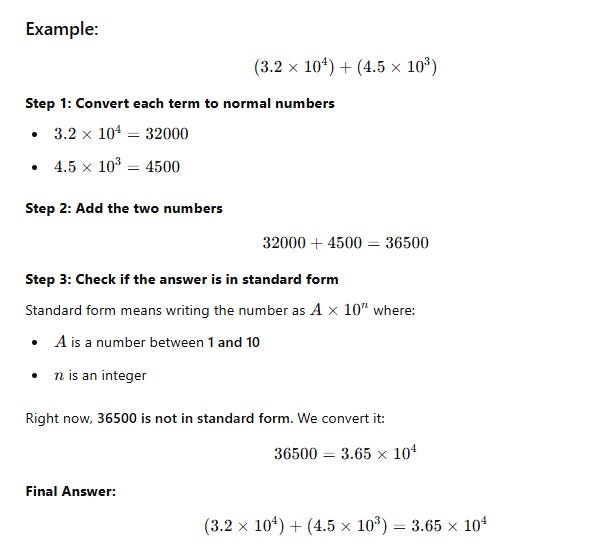This lesson is all about Standard Form—a simple way to write very large or very small numbers without all the extra zeros!
https://uk.ixl.com/maths/year-10/convert-between-ordinary-numbers-and-standard-form
https://uk.ixl.com/maths/year-10/add-and-subtract-numbers-written-in-standard-form
https://uk.ixl.com/maths/year-10/add-and-subtract-numbers-written-in-standard-form
https://uk.ixl.com/maths/year-10/divide-numbers-written-in-standard-form
Let's begin with a story.
The Story of Two Scientists and Their Shortcut.
Dr. Alex and Dr. Sam are busy in their laboratory, peering into a microscope to study bacteria.
The experiment is going well when suddenly, Dr. Sam’s phone rings.
"It's urgent! I need to step out," Sam says, rushing toward the door. "Just write down the results—I’ll check them later!"
Dr. Alex nods and turns back to the microscope.
"Wow! There are 4,500,000 bacteria here," Alex mutters. But there’s a problem—writing all those zeros will take forever!
Plus, Alex won’t be there when Dr. Sam returns, so the information needs to be quick and easy to understand.
Luckily, both scientists know the shortcut.
Instead of writing 4,500,000, Dr. Alex quickly writes:
👉 4.5 × 10⁶
Dr. Sam doesn’t need to be there to understand it—they both know the rules of Standard Form, so when Sam returns, he will immediately recognize that this means 4,500,000.
Meanwhile… Sam Has His Own Problem!
When Dr. Sam returns, he’s on his own. He checks another sample and finds 0.00032 grams of a rare chemical.
But now, Sam is in a hurry—he needs to get home to watch the football!
Writing all those zeros would slow him down, so he uses the same shortcut:
👉 3.2 × 10⁻⁴
Both scientists understand each other’s work without writing long numbers—that's the power of Standard Form!
Standard Form in Mathematics also called (Scientific Notation)
Standard Form is used to express very large or very small numbers in a shorter way. Instead of writing long numbers with lots of zeros, we use a simpler format.
Standard Form follows this pattern:
A number between one and ten multiplied by ten to the power of something.
This means:
The first number must be between one and ten (but it can have decimals).
The power of ten tells us how many places the decimal moves.
Examples:
1️⃣ Four thousand five hundred written in standard form:
The number is four thousand five hundred.
We write it as four point five multiplied by ten to the power of three.
2️⃣ Zero point zero zero seven two written in standard form:
We write it as seven point two multiplied by ten to the power of negative three.
Final Rule Summary for what we did above:
✅ Big numbers → Move decimal left → Positive exponent (power)
✅ Small numbers → Move decimal right → Negative exponent (power)
Lesson: Standard Form (with Jumps!)
Question 1: Convert 4,500,000 into Standard Form
Starting number: 4,500,000.
The decimal is at the end.
Now, we jump left (MOVE THE DECIMAL) until the number is between 1 and 10:
Now, move the decimal left step by step:
Corrected Version:
⬅ 450,000.0 (Jump 1)
⬅ 45,000.00 (Jump 2)
⬅ 4,500.000 (Jump 3)
⬅ 450.0000 (Jump 4)
⬅ 45.00000 (Jump 5)
⬅ 4.500000 (Jump 6) ✅ Stop!
Final Answer: 4.5 × 10⁶
We moved 6 jumps, so:
Final Answer:
📌 4.5 × 10 to the power of 6
Question 2: Convert 0.00032 into Standard Form
Starting number: 0.00032
The decimal is at the front.
Now, we jump right until we land between 1 and 10:
Starting number: 0.00032
➡ 0.0032 (Jump 1)
➡ 0.032 (Jump 2)
➡ 0.32 (Jump 3)
➡ 3.2 (Jump 4) ✅ Stop!
We moved 4 jumps, so:
Final Answer: 3.2 × 10⁻⁴
More Challenging (Jumps for Decimal Movement)
Question 3: Convert 7.08 × 10⁵ into a normal number
Starting number: 7.08
A power (also called an exponent or index) 5 means we jump right 5 times.
7.08
➡ 70.8 (Jump 1)
➡ 708. (Jump 2)
➡ 7080. (Jump 3)
➡ 70800. (Jump 4)
➡ 708000. (Jump 5) ✅ Stop!
Final Answer:
708000
Question 4: Convert 9.5 × 10⁻³ into a normal number
Starting number: 9.5
A power (also called an exponent or index) -3 means we jump left 3 times.
9.5
⬅ 0.95 (Jump 1)
⬅ 0.095 (Jump 2)
⬅ 0.0095 (Jump 3) ✅ Stop!
Final Answer:
0.0095
Clarified Quick Recap:
✅ When converting from a normal number to standard form:
Move decimal left for big numbers → Positive power.
Move decimal right for small numbers → Negative power.
✅ When converting from standard form to a normal number:
Positive power → Move decimal right (big number).
Negative power → Move decimal left (small number).
Now You Try!
Convert 23,000,000 into standard form using jumps.
Convert 4.7 × 10⁻² into a normal number with jumps.
Let me know your answers! 🐸⬅➡ 🎯
Harder ones with brackets.
This method can be applied to any similar problem:
Convert each term to an ordinary number.
Perform the operation (addition or subtraction).
Convert back to standard form if needed.
Let me know if you need another example or a different explanation! 😊
Multiplication Standard Form
Multiplication Standard Form with negative
Key Steps Recap:
Convert each term from standard form to an ordinary number.
Perform the subtraction as normal.
Convert the result back into standard form if needed.
Let me know if you'd like another example! 😊
When number is bigger than 10














